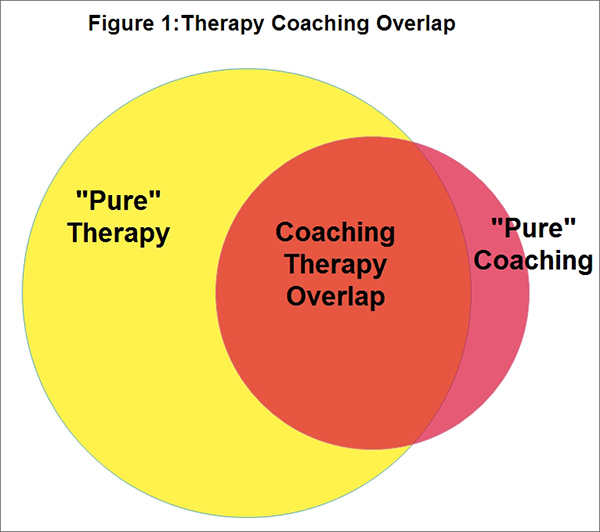Towards An Integrated Understanding of Coaching & Therapy
Coaching has a very large overlap with therapy. Therapy maintains a significant base of activity that is clearly outside the bounds of therapy and cannot be done by coaches. On the other hand, only a limited part of what coaches do might be uncomfortable territory for most contemporary therapists. In the middle of the two professions, there is significant overlap. This overlap is illustrated in Figure 1.
Given the significant overlap is fair to ask what whether coaching is simple a step-child of therapy. There are, I think, three relevant differences that make coaching distinct from therapy. First, therapy tries to be a research and scientifically evaluated profession. This means that interventions that are tested using double blind research designs are particularly valued and held out as the “gold standard” in therapy. That being said, this valuing of research also imposes some limitations on what can be included in therapy. Some interventions which are outside of therapy seem to be quite popular in coaching. For example, the “law of attraction” appears to be important to the work of many coaches while therapists would tend to see such beliefs as lacking an evidence base. Neuro-linguistic programming provides another example. Originally a form of therapy, neuro-linguistic programming has been long rejected by mainstream therapy as scientifically unsupportable but it is still embraced by significant numbers of coaches and is often included in coach training programs.
Second, the singular emphasis in coaching on the “client as expert” is quite different in tone than most therapy. While therapists highly value client input, participation, and problem solving therapists are far more comfortable supplementing client processes with therapist expertise. It is hard to know whether pure coaching has advantages in efficacy. I am unaware of any controlled research that has evaluated whether pure coaching produces better outcomes than coaching that includes coach provided expertise. In the future, we may well find that the “client as expert” stance of pure coaching is superior… or we may not! For today, however, it is safe only to say that the emphasis that coaching places on this point distinguishes coaching from most therapy.
Finally, there is no dispute about the differences between coaching and therapy when it comes to professional training, credentialing, and licensing. Therapy is generally provided by established and fully professionalized disciplines and is generally licensed and regulated. Coaching is almost wholly unregulated and there are no generally accepted standards for who can claim to be a coach and who cannot. A client selecting a coach can have some level of comfort about the competence of the therapist based on standardization of preparation and licensing. In addition, there is board of licensing and regulatory agency recourse for client complaints. Selecting a coach is far more of a “buyer beware” transaction. This creates a competitive disadvantage for coaches. All things being equal, clients will tend to select a profession with stronger credentials and who is subject to greater regulatory scrutiny. It may well be that much of the intensity about distinguishing coaching from therapy is rooted in this potential for weaker market position. If coaching cannot achieve distinctive status, it risks being subsumed by a group that values credentials and training that most coaches lack.
In closing, I suggest that coaching is best seen a specialized form of counseling designed to assist people with non-clinical needs to engage in a thought-provoking and creative process that inspires them to maximize their personal and professional potential. While rooted in clinical tools, frameworks, and practices, coaching maintains a central priority on supporting the client in discovering their own personal path rather than providing advice, mentoring, or direct guidance. In time, it will probably be necessary for coaching to become more standardized and regulated. It remains to be seen whether this increases its distinctiveness relative to therapy or diminishes it.
